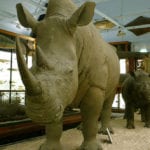 Mysteries
Mysteries  Mysteries
Mysteries  History
History 10 Surprising Stories About the Texas Rangers
 Humans
Humans 10 Philosophers Who Were Driven Mad by Their Own Theories
 Miscellaneous
Miscellaneous 10 Video-Game-Worthy Weapons and Armors from History
 Weird Stuff
Weird Stuff 10 Psychics Who Accurately Predicted Wartime Events
 The Arts
The Arts 10 Pieces of Art Inspired by a Broken Heart
 Health
Health 10 Science Fiction-Sounding New Medical Treatments
 History
History 10 Surprising Facts About the Father of Submarine Warfare
 Space
Space Ten Astonishing New Insights into Alien Worlds
 Weird Stuff
Weird Stuff 10 Bizarre Summer Solstice Rituals Still Practiced Today
 Mysteries
Mysteries Top 10 Haunting Facts About the Ghost Ship MV Alta
 History
History 10 Surprising Stories About the Texas Rangers
 Humans
Humans 10 Philosophers Who Were Driven Mad by Their Own Theories
Who's Behind Listverse?

Jamie Frater
Head Editor
Jamie founded Listverse due to an insatiable desire to share fascinating, obscure, and bizarre facts. He has been a guest speaker on numerous national radio and television stations and is a five time published author.
More About Us Miscellaneous
Miscellaneous 10 Video-Game-Worthy Weapons and Armors from History
 Weird Stuff
Weird Stuff 10 Psychics Who Accurately Predicted Wartime Events
 The Arts
The Arts 10 Pieces of Art Inspired by a Broken Heart
 Health
Health 10 Science Fiction-Sounding New Medical Treatments
 History
History 10 Surprising Facts About the Father of Submarine Warfare
 Space
Space Ten Astonishing New Insights into Alien Worlds
 Weird Stuff
Weird Stuff 10 Bizarre Summer Solstice Rituals Still Practiced Today
10 Hilariously Weird Ig Nobel Prize Wins
To win a Nobel Prize is one of the greatest honors in the academic world. Scientists, writers, politicians, journalists, and more are nominated each year to receive the coveted award at the Nobel Prize Ceremony, held in Stockholm. While the Nobel Prize Foundation’s committee is busy deciding who will be recognized for their outstanding contributions to society that year, another group is making selections of a different type.
The Annals of Improbable Research is a satirical magazine that publishes news of real but peculiar goings-on in the world of science. Each year, they celebrate individuals who have made a mark with their strange and humorous scientific research. This lighthearted award is designed to “honor achievements that make people laugh, then think,” and its ceremony is held at Harvard University every September.
Here are ten hilariously weird winners of the Ig Nobel award.
Related: 8 Craziest Celebrity Award Show Conspiracy Theories
10 Researcher Lives as a Goat
In 2016, the Ig Nobel Biology Prize was awarded jointly to Charles Foster and Thomas Thwaites. Throughout his career, Foster, who is an Oxford University graduate, lived in the wild as a bird, a badger, a deer, an otter, and a fox. He explains that his motivation in all his research is to discover “who or what are we?” and “what on earth are we doing here?”
Thomas Thwaites, however, had his own reasons for building prosthetic leg extensions and traveling to the Alps to live among a herd of goats. He explains, “I tried to become a goat to escape the angst inherent in being a human. The project became an exploration of how close modern technology can take us in fulfilling an ancient human dream: to take on characteristics from other animals.”[1]
9 Levitating Frogs
Andre Geim of the University of Nijmegen, the Netherlands, and Sir Michael Berry of Bristol University, England, won the prize in physics for their research into levitation. Using a Levitron, a device consisting of opposing magnets that interact to create a magnetic field, the researchers managed to levitate a living frog six feet (1.82 meters) into the air.
Frogs weren’t the only species to have a turn floating in mid-air, however. The researchers also caused a fish to levitate, as well as a mouse and some vegetables. Geim’s brilliant mind and out-of-the-box thinking have earned him the distinction of being the first person ever to be awarded the Nobel Prize, as well as the Ig Nobel Prize.[2]
8 Management vs. Voodoo
In 2017, the Ig Nobel Economics prize was taken home by six researchers for their joint effort in discovering whether voodoo dolls could be used to help employees deal with their abusive bosses. The team states that it is natural for people to want to retaliate against mean management but also that direct retaliation may do more harm than good. The solution? Round up a large group of employees, give them access to voodoo dolls, ask the participants to name the doll with the initials of their boss, and go to town!
Using pins, pliers, and flame, the group was encouraged to punish the little playthings while thinking of a time they were wronged by their doll’s namesake. The results speak for themselves. After beating up their voodoo dolls, the participants experienced a reduction in their internal sense of injustice. Not to worry, though. None of the ills inflicted on the voodoo dolls affected management… we think.[3]
7 Insect Stings on the Penis for Science
Justin Schmidt was jointly awarded the Physiology and Entomology prize for his mission to rank over 83 insects based on the painfulness of their sting. Outrageously, Schmidt took it upon himself to personally experience each and every sting. With the results of his research, he created the Schmidt Sting Pain Index, which sorted each creature on a scale of 1 to 4. Schmidt rated one of the most painful stings as coming from the bullet ant. He ranked its sting as a 4 and described it as “pure, intense, brilliant pain. Like walking over flaming charcoal with a 3-inch nail embedded in your heel.”
The other winner that year was Michael L. Smith. He conducted his research into the painfulness of a honey bee’s sting. Not just once but 28 times, all over his body, including the back of his knee, the arch of his foot, and his nipple. He then ranked their painfulness on a scale of 1 to 10. Smith stated that the most painful places to be stung by a bee were on the nostril, the upper lip, and the penis shaft.[4]
6 Tanks for Solving a Parking Issue
It’s not only scientific researchers who are awarded for their ingenuity when it comes to the Ig Nobels. Arturas Zuokas, the mayor of Vilnius, Lithuania, in 2011, took to the streets to remedy the problem of luxury car owners parking illegally and blocking the city’s bicycle lanes. Using a tank-like armored vehicle, Zuokas was filmed joyfully rolling over an expensive-looking car, completely crushing it.
Available for viewing on YouTube, the narrator in the video states that a tank is the best solution to deal with drivers who think they’re above the law. Whether the action was genuine or a stunt remains to be seen but likely left local drivers wondering if parking illegally is worth the risk.[5]
5 Narcissists and Their Eyebrows
The 30th First Annual Ig Nobel Prize Ceremony, which was held in 2020, was the first time the ceremony was hosted online due to the COVID-19 pandemic. Miranda Giacomin and Nicholas Rule jointly received the Psychology Prize. Their research was dedicated to discovering whether those with grandiose narcissism can be identified by only the thickness and density of their eyebrows.
The broader aim of the pair’s research was to potentially help others identify narcissists in their everyday lives and thereby know who to avoid. Throughout their experiments, the researchers claim that “distinctive eyebrows reveal narcissists’ personality to others, providing a basic understanding of the mechanism through which people can identify narcissistic personality traits with potential application to daily life.”[6]
4 Do I Smell Bacon?
In 2014, a group of four researchers from the Detroit Medical Center in Michigan discovered that sometimes old treatments are just what the doctor ordered. For those who suffer from serious recurring nosebleeds, all manner of remedies have been tested over the years, mainly in the form of packing the nose with different materials.
In this particular case, the four researchers decided to give an old wives’ tale a try. And it worked. A patient’s serious nosebleed disorder was treated like this: “cured salted pork crafted as a nasal tampon and packed within the nasal vaults successfully stopped nasal hemorrhage promptly, effectively, and without sequelae.” If it works, it works![7]
3 Wombat Mystery Poop
Bare-nosed wombats are chubby, cuddly-looking marsupials that are endemic to Australia. Their closest living relative is the koala, with which they share their herbivorous diet. Unlike koalas, however, they have cube-shaped poop. In fact, wombats are the only known animals to have this unusual dung. And in 2019, a group of seven researchers came together to get to the bottom of it.
Wombats who had previously fallen victim to South Australian drivers were collected and dissected by the team who examined them. It was established that wombats have circular bottoms, not square and that the molding actually takes place inside the intestines. Some parts of the intestine turned out to be firm, while other sections were soft. This, combined with the way the insides contract during digestion, was what turned out to produce the poop that had previously been a mystery to us all.[8]
2 Beards for Self Defense
Beards—what are they good for? Catching crumbs? Attracting mates? How about dampening punches to the face? In 2021, Ethan Beseris, Steven Naleway, and David Carrier completed their research into the topic and won an Ig Nobel Peace prize as a result. Instead of having volunteers struck in the face for science, prosthetic bones were created for the experiment and covered in sheepskin. Some of these samples had wool intact, while some had been shorn. They were then struck, and the pressure was measured.
The results did indeed show that hair (or wool) absorbs a significant amount of blunt force. Some researchers have hypothesized that, like male lions, male humans may have developed longer hair around the neck and jaw to protect these delicate areas from attack.[9]
1 Decongestants or Orgasms?
In 2016, a small team of researchers from Germany, Turkey, and the UK worked together to discover whether sexual orgasms can compete with decongestants when it comes to clearing the airways. The group states that “a physiological connection between the nose and the genitals has long been proposed.” One of the men who once delved into this area of research was an ear, nose, and throat doctor and a close friend of Sigmund Freud.
Instead of a strange Freudian link, however, the relation between sex and clearing a blocked nose may be down to the combination of physical exercise along with the hormonal changes that occur during intercourse. Both of these things have previously been shown to have decongestant properties. Either way, the results were clear. Sexual climax can improve nasal breathing to the same degree as a nasal decongestant for up to 60 minutes in those with a blocked nose. Good to know for the cold and flu season![10]








